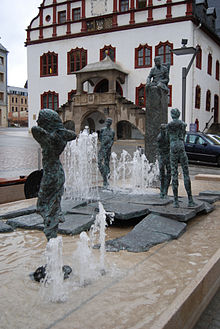Art cast

The term artificial casting describes the production of a copy of a plastic, artistic object. Usually it is a clay model created by an artist . A negative form is created from the model of a sculpture or a relief made of clay or wax using a suitable material . The liquefied material (“food”) of the copy to be produced is then poured into this negative mold. After the cast material has solidified, the mold is separated from the finished copy.
The aim is to reproduce the artist's “handwriting” as reproduced by the model by means of precise surface molding without further post-processing by the chaser . Not only the molding process, but also the casting method and the alloy used determine the quality of the work. In addition to the artist's signature, the ore caster's foundry mark can be found as a mark of quality.
Depending on the process, production requires multiple molding from the model to the finished copy. In addition, the negative form is often destroyed during casting. In this case, a new mold must be made for another copy ( lost mold , bronze casting ). The creation of a high quality art casting is complex and requires a high level of experience on the part of the art caster . The high costs arise mainly from the work of the artist and the caster and less from the material costs (bronze).
Mainly due to the monumental bronze casting, an industrial landscape of specialized art foundries with a high export share developed in Europe, especially in Germany and France .
Bronze casting occupies a special position within art casting . The process was developed during the Bronze Age and its main features are still used today. It is one of the oldest crafts at all. Over the millennia, the technology has only been refined and expanded.
The methods of art casting are diverse and include u. a. the techniques of lost wax casting , sand molding , the lost shape and the subtractive molding method according to Benno Werth .
Materials commonly used for the later original include: a. Bronze , copper , iron , aluminum , tin or plaster of paris .
Common materials for creating the negative include: a. Plaster of paris , latex , silicone and ceramics (bronze casting).
Common materials for creating the model include: a. Clay , wax and plaster .
See also
- Patination (surface treatment of the cast sculpture)
- Assembling (assembling of cast parts into a total work of art)
- Cast
- Iron art casting museum
- Art casting museum Lauchhammer
literature
- Mietzsch, Andreas (ed.): Bronze casting - handicraft for art . 2nd Edition. Zentralverlag Berlin, 2013, ISBN 978-3-9812417-0-9 .
Web links
- With iron casting in antiquity a contribution to the bronze school in Lauchhammer at Monumente Online
- Bronze casting - photos + information
